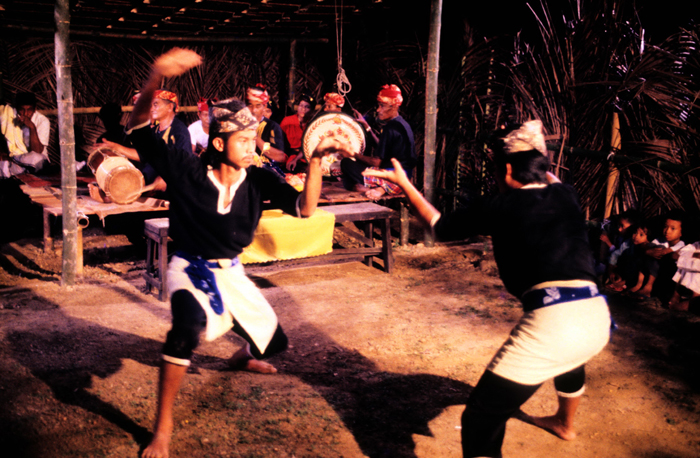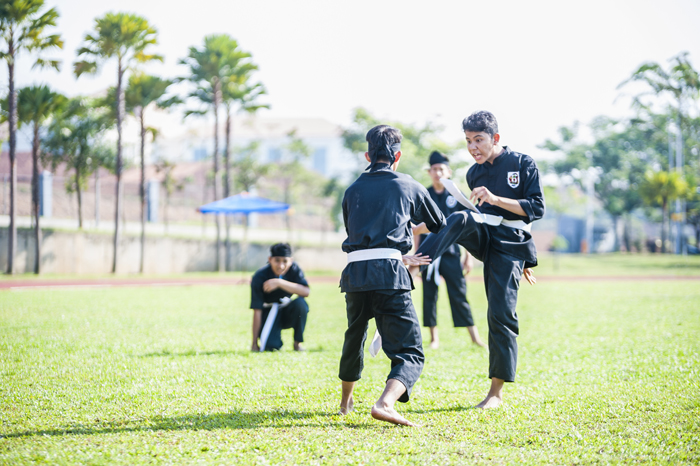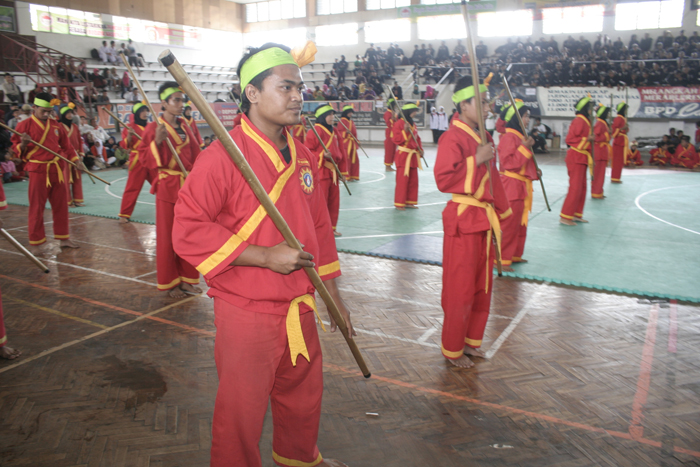Silat: A Powerful Martial Art Blending Culture and Combat

Welcome to the exciting world of Silat, a martial art that has its roots deeply embedded in the history and culture of countries like Indonesia, Malaysia, and the Philippines. It is a martial art that emphasizes self-defense while also teaching unique fighting techniques, including various types of striking and grappling.
Silat is not just a form of self-defense or way of fighting; it is a dance, a meditation, and a living tradition that has been passed down through generations. From the beautiful display of techniques to the intricate use of traditional weapons, Silat offers a unique experience like no other martial art.
If you’re curious about Silat and how it blends Indonesian culture, dance, weapon mastery, and martial arts techniques, then look no further. Join me in this article, where I will reveal the principles of Silat and its amazing techniques.
The Origins of Silat

The history of Silat makes it an interesting blend of various tales that span across Southeast Asia. Its history is linked to old martial arts traditions, including significant influences from Indian and Chinese martial arts. Many stories have been told about where the martial art came from and who inspired the wild techniques of Silat. However, none are set in stone, and different countries and regions have their own version of where the martial art originated. This makes the history of Silat quite mysterious and adds more depth to its persona.
Indian martial arts are thought to have influenced Silat through the spread of Hinduism and Buddhism, which brought with them not only spiritual practices but also fighting techniques that were absorbed into the local martial arts culture. These techniques often emphasized leverage, joint manipulation, and pressure point strikes, which are seen in Silat’s joint locks and precise strikes.
Chinese martial arts are also believed to have contributed to Silat through the migration of Chinese traders and settlers to Indonesia and other parts of Southeast Asia. The fluidity of motion, the concept of internal energy, and the use of circular movements in combat are characteristics of Chinese martial arts like Kung Fu. This can also be seen in Silat’s dynamic and flowing techniques, which are quite acrobatic. The importance of balance, breathing, and graceful movements are also aspects where Chinese martial arts may have been influenced.
This Indonesian martial art is not only a melting pot of martial arts techniques; Indian and Chinese martial arts may have also influenced the culture of Silat, including its medicinal practices and weapons training. However, Silat is not just linked to Indonesia but also to Malaysia and the Philippines. Malaysia, with its own rich history and cultural diversity, has played a crucial role in the evolution of Silat.
The martial art is a large part of Malaysian culture, where it is known as Silat Melayu. In Malaysia, Silat is not only a method of self-defense but also a ceremonial performance that is often performed during cultural events and weddings. Some even claim that Silat might have first begun in Malaysia; however, it is largely known for being an Indonesian martial art. There are also many Malaysian and Indonesian stories surrounding martial arts. This folklore makes the history even more interesting and makes it difficult to pinpoint its exact origins. Nonetheless, Silat is now an integral part of Southeast Asian culture, particularly in Indonesia and Malaysia.
The Principles and Culture of Silat
Silat embodies a set of fundamental principles, which include honor, respect, and spiritual development. The martial art is deeply connected to the concept of “adat,” which refers to the traditional customs of ancient Indonesian tribes. Silat also develops a sense of community and brotherhood among its practitioners, which forms a spirit of unity within the martial art. Students are encouraged to be courteous and respect each other, especially when practicing techniques.
Another spiritual aspect of Silat also includes meditation, which focuses on inner peace and mental discipline. Meditation is a common practice in some Asian martial arts, and it is practiced as a way of aligning the mind and body to achieve a harmonious state.
The cultural rituals of Silat, such as the “kuntau” or the “pesilat dance,” display the beautiful movements and the philosophical elements that blend combat techniques with dance-like performances. This is quite unique to Silat, as it doesn’t just focus on combat techniques like some martial arts.
Grappling, or Gulat in Indonesia and Gelut in Malaysia, is integral to Silat, showcasing unique wrestling techniques. Additionally, Silat’s fluidity and intricacy of movements are emphasized through speed and agility, which ensure that techniques are executed with precision. The martial art also offers techniques for rapidly disabling opponents, such as distractions, destabilizing the adversary, and preserving one’s agility to deliver decisive strikes.
Styles and Regional Variations

There are a variety of Silat styles and variations. Each style presents unique techniques, weapons, and cultural influences, creating a diverse tapestry of this martial art. These styles are specific to certain regions and areas. I will explore some of these styles down below, starting with the Minangkabau and Sunda styles of Pencak Silat.
Pencak Silat
Pencak Silat, or Pentjak Silat, is a broad term that is used to cover all the styles of Indonesian Silat. Many regions of Indonesia have their own unique styles, such as the Pencak Silat Harimau or Silat Minangkabau from the Minangkabau region, which resemble the movements of the tiger.
These regional styles of Silat mean that Pencak Silat is a unique martial art with many different ways of teaching it. In total, there are around 150 styles of Pencak Silat in Indonesia. Although Silat does have techniques that are practiced in most of the styles of Indonesian Silat.
The variation in styles doesn’t totally change the martial art of Pencak Silat. Pencak Silat is generally what people are referring to, as this is the most popular way to practice the martial art.
Techniques of Pencak Silat include:
- Striking techniques – including punches, elbow strikes, kicks, and knee strikes for offensive maneuvers
- Joint manipulation – applying locks to control or disable joints
- Throws and takedowns – using leverage to off-balance and bring an opponent to the ground
- Sweeps – techniques designed to trip or knock down an opponent
- Ground fighting – controlling an opponent using various techniques while on the ground
- Weapons training – proficiency with traditional weapons such as the kris, staff, and machete
- Defensive maneuvers – blocks, evasions, and parries to protect oneself from attacks
- Counterattacks – responding to an opponent’s attack with an effective counter technique
- Mental conditioning – developing the mental resilience and strategic thinking required in combat
Not all styles of Silat will be the same, but the most common styles of Silat are the Indonesian variations of Pencak Silat. You can find Pencak Silat being taught worldwide, whereas other styles are usually national or regional styles of Silat, which will be difficult to find internationally.
Silat Melayu
Silat Melayu is a style of Silat that is deeply woven into the fabric of Malaysian traditions. It is often showcased in the form of a graceful dance during special occasions such as weddings. At such events, practitioners perform Silat Melayu not only as a martial art demonstration but also as a symbolic act of respect and blessing for the newlyweds.
The movements of Silat Melayu are based on self-defense methods, but they are performed with such grace and elegance that they become a beautiful dance and cultural ceremony that tells tales of love and harmony. At weddings and celebrations, Silat Melayu represents the harmony and beauty of Malaysian tradition.
Seni Gayong
Silat Seni Gayong is the official martial art of Malaysia. It is recognized for its historical significance and cultural depth. Practitioners of Seni Gayong learn a wide array of skills, from hand-to-hand combat to weapons mastery, with an emphasis on discipline and ethical conduct.
The art form is traditionally passed down from master to student, ensuring the preservation of its ancient techniques and philosophies. In Silat Seni Gayong, students are taught to respect their opponents and to use their skills responsibly. This reflects the art’s underlying principles of self-defense and personal development.
Like Silat Melayu and Silat Seni Gayong, it is often demonstrated in cultural performances, symbolizing the rich heritage and ongoing legacy of the Malaysian people. However, Silat Seni Gayong is more certainly a combat system and martial art, not just a cultural practice. Overall, it has a lot of similarities to both Pencak Silat and Silat Melayu.
Techniques and Training Methods
Silat practitioners dedicate themselves to learning proper stances, which are crucial for establishing balance and a strong base. They are also required to master footwork, which allows for fluid and strategic movement during combat. Forms, also known as ‘Jurus,’ are practiced to perfect movements and techniques. One very important aspect of Silat is sparring, an essential part of training that provides the opportunity to apply these techniques in a controlled environment. Let’s take a further look at these techniques and training methods in more detail.
Stances and Footwork
In Silat, stances and footwork form the fundamentals for movement and balance. The Sikap Pasang #3, characterized by a side stance with the right hand extended and the left hand crossed in front, is one of the fundamental stances that practitioners learn.
Footwork is equally important, enabling practitioners to:
- Maneuver seamlessly and effectively
- Make themselves elusive targets
- Amplify the impact of their strikes
- Launch attacks or counter from diverse angles
- Establish advantageous positioning
Forms and Jurus
Forms, or jurus, in Silat are:
- Predetermined sequences of steps and movements
- Also referred to as katas
- Serve the purpose of honing proper technique
- Enhancing agility
- Conditioning the body
Consistent practice of forms and jurus offers numerous advantages, including enhanced control of breathing, improved coordination, increased strength, and better overall technique. Although some people might not consider practicing forms to be practical, they can improve your overall Silat ability.
Sparring and Conditioning
Sparring and conditioning are crucial aspects of Silat training. Several specific sparring techniques are practiced to cultivate functional fighting abilities and fighting spirit, including fighting techniques such as:
- Rotational techniques like spinning attacks
- Sweeps
- Throws
- Off-balancing maneuvers
Conditioning exercises in Silat are designed to enhance muscular strength and endurance. This allows practitioners to effectively perform self-defense techniques when confronted with genuine threats. Sparring usually requires safety gear like a body guard, as there is a lot of kicking and sweeps involved in Silat sparring. Head strikes are usually not so common in Silat sparring, but when permitted, head gear will usually be worn.
Weapons in Silat

An element of Pencak Silat that makes it stand out when compared to other martial arts is the weapon training. It is an integral component of Pencak Silat, which reflects the martial art’s legendary tales. Practitioners are taught to master a variety of traditional weapons, including the kris (a wavy-bladed dagger), parang (a large knife), and rattan staff, which enhance their understanding of range, timing, and technique.
- Kris – A distinctive wavy-bladed dagger that is both a weapon and a spiritual symbol
- Parang – A large knife or machete used in Silat for slashing and chopping techniques
- Rattan staff – A long, sturdy staff made of rattan used for striking, blocking, and controlling the opponent’s weapon
- Machete – Similar to the parang, a broad blade used for powerful chopping and slashing movements
- Sickle – A curved, hand-held agricultural tool that can be adapted for close combat and controlling movements
- Spear – A long pole weapon with a pointed end, ideal for thrusting at an opponent from a distance
- Kerambit – A small, curved knife resembling a claw, used for hooking, ripping, and tearing in close-quarter combat
- Sarong – A traditional fabric that can be utilized as a flexible weapon for defense, trapping, and binding an opponent’s limbs
- Golok – A versatile cutting tool resembling a machete, used for both utilitarian tasks and as a formidable weapon in Silat
- Pedang – A traditional sword with a straight or slightly curved blade, used for precise cutting and thrusting movements
- Kelawang – A sickle-shaped weapon with a crescent blade, often used for quick slicing actions and surprise attacks
In Silat, even a simple piece of cloth, like a sarong, can become a versatile weapon for defense against blades and can be employed for locks, holds, and trapping the limbs or weapon hands of an opponent. This makes Silat a very unique martial art, as there are not many modern martial arts that teach practitioners how to master diverse weaponry.
How to Get Started with Silat
If you’re motivated to begin your Silat journey, identifying a qualified instructor and a secure training facility is an ideal first step. It’s usually a good idea to start your research online and look for a local gym, somewhere you will feel happy to train Silat.
When searching for a Silat gym, consider the following factors:
- The variety of techniques offered
- The enthusiasm of the students
- The experience and credentials of the instructors
- The facility’s commitment to cleanliness and safety
- The affordability of the cost
- The distance from your home to the Silat gym
As a novice practitioner of Silat, it is essential to have a training uniform that allows for unrestricted movement, non-slip footwear, and, optionally, other equipment like training weapons for practice. Although there is no need to worry about this, the instructor will guide you on how and where to buy the appropriate gear.
As a beginner, the amount of time you train or how many classes you attend per week will likely be suggested by the gym instructor. Silat practitioners are encouraged to train often, but Silat is not a combat sport like mixed martial arts. This means you will not need to attend classes every day as you are preparing for a lifestyle in Silat, not a fight.
Silat in the International Arena
Silat’s international recognition has positively impacted its global reputation, attracting international attention and support. Today, Silat communities are thriving in nations such as:
- United States
- Canada
- Australia
- United Kingdom
Despite its wide recognition, there are some practitioners who believe that Silat has not yet earned its merits. However, the growth of Silat communities worldwide and its inclusion in international martial arts events show that this unique martial art is well on its way to gaining the global recognition it deserves.
Silat Organizations and World Championships
Silat has a structured community with various organizations dedicated to preserving and promoting the art form. Organizations like the International Pencak Silat Federation (PERSILAT), or Persekutuan Pencak Silat Antarabangsa in Indonesian, oversee the standardization of techniques, rules, and regulations for competitions and grading systems.
Other organizations, like the Persekutuan Silat Singapura of Singapore, the Persekutuan Silat Kebangsaan Malaysia, and the Indonesian Pencak Silat Association, are all national organizations that facilitate training and preserve the Silat culture in their respective countries.
These organizations also work to spread the art of Silat globally through seminars, workshops, and tournaments. World championships in Silat, such as the Pencak Silat World Championships, provide a platform for practitioners from around the world to compete and showcase their skills.
These events are not only a test of martial prowess but also a celebration of cultural exchange and sportsmanship. The championships are held periodically and attract competitors from various countries, highlighting the growing international community of Silat practitioners and the martial art’s significance on the world stage.
Frequently Asked Questions
Can silat beat MMA?
Silat, like Penchak Silat, is a martial art based on close-quarter combat and weapon warfare, with a focus on real-life combat. This means Silat is a martial art not designed for sports, as they also teach weapons training. Therefore, it might not work so well in an MMA fight.
What style of fighting does John Wick use?
John Wick primarily uses gun fu, a combination of marksmanship principles and martial arts, in his fighting style. He also incorporates the Filipino martial art known as Arnis for bladed encounters.
Is silat used in the military?
Yes, silat has been used in the military for centuries in Southeast Asia, and it is still used by the defense forces of various Southeast Asian kingdoms and states.
What are the origins of Silat?
The origins of Silat can be traced back to the eighth century in the Southeast Asian region, particularly around the Bukit Siguntang Mahameru kingdom in Palembang, Sumatra, Indonesia. However, the exact origins are not entirely clear, as many regions tell different tales of where the martial art originated.
What are the core principles of Silat?
The core principles of Silat revolve around self-defense, conflict avoidance, and a steadfast refusal to retreat when confronted with a threat. This martial art emphasizes perseverance and protection rather than aggression.
Summary
Silat is a martial art that has a rich cultural heritage and practical combat skills. Its diverse set of techniques, along with its vibrant culture, make it an exciting martial art to practice.
Whether you are interested in self-defense, personal growth, cultural exploration, or simply wish to engage in a physical activity, Silat offers something for everyone.









